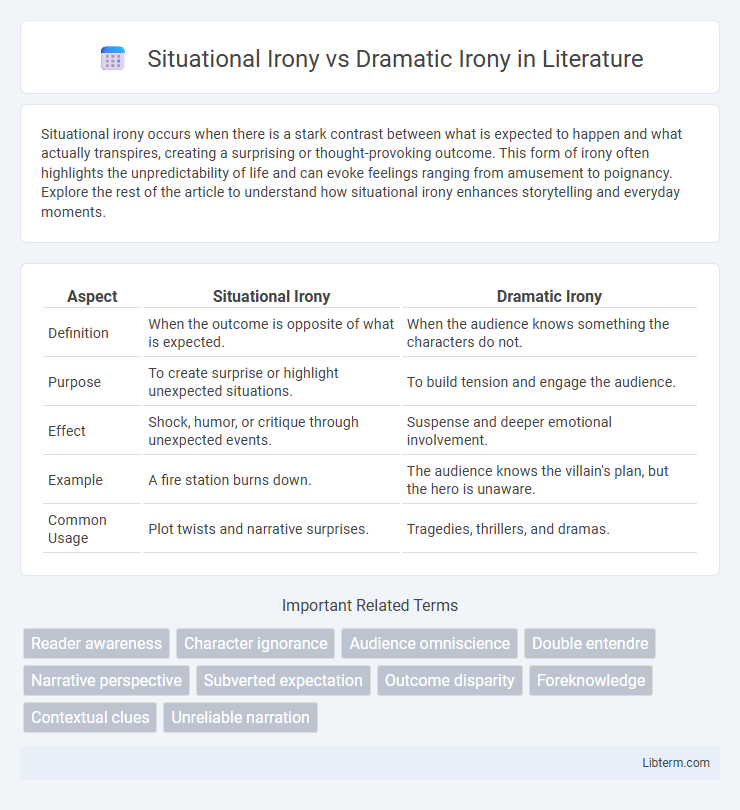Situational irony occurs when there is a stark contrast between what is expected to happen and what actually transpires, creating a surprising or thought-provoking outcome. This form of irony often highlights the unpredictability of life and can evoke feelings ranging from amusement to poignancy. Explore the rest of the article to understand how situational irony enhances storytelling and everyday moments.
Table of Comparison
| Aspect | Situational Irony | Dramatic Irony |
|---|---|---|
| Definition | When the outcome is opposite of what is expected. | When the audience knows something the characters do not. |
| Purpose | To create surprise or highlight unexpected situations. | To build tension and engage the audience. |
| Effect | Shock, humor, or critique through unexpected events. | Suspense and deeper emotional involvement. |
| Example | A fire station burns down. | The audience knows the villain's plan, but the hero is unaware. |
| Common Usage | Plot twists and narrative surprises. | Tragedies, thrillers, and dramas. |
Introduction to Irony in Literature
Situational irony occurs when there is a stark contrast between expected outcomes and actual events, creating an unexpected twist that surprises the audience. Dramatic irony arises when the audience possesses critical knowledge unknown to the characters, generating tension and deeper engagement with the narrative. Both forms of irony serve as powerful literary devices that enhance storytelling by emphasizing contradictions between appearance and reality.
Defining Situational Irony
Situational irony occurs when there is a stark contrast between the expected outcome and the actual result in a particular situation, often leading to an unexpected twist. This form of irony highlights the unpredictability of events by subverting anticipated consequences, such as a fire station burning down or a pilot with a fear of heights. Distinct from dramatic irony, which involves the audience knowing crucial information unknown to the characters, situational irony revolves around the outcome of events being contrary to what is logically anticipated.
Defining Dramatic Irony
Dramatic irony occurs when the audience is aware of critical information that the characters in a narrative do not know, creating tension and engagement. Situational irony, by contrast, involves a discrepancy between expected outcomes and actual events. In dramatic irony, this gap in knowledge heightens suspense as viewers anticipate the characters' realization of the truth.
Key Differences: Situational vs Dramatic Irony
Situational irony occurs when there is a stark contrast between expected outcomes and actual events, often surprising both characters and the audience, while dramatic irony arises when the audience possesses knowledge that the characters do not, creating tension and anticipation. The key difference lies in the awareness of the irony: situational irony surprises all parties equally, whereas dramatic irony depends on the audience's superior insight. Understanding these distinctions enhances the analysis of narrative techniques in literature, film, and theater.
Common Examples of Situational Irony
Common examples of situational irony include a fire station burning down, a police officer getting arrested, or a pilot with a fear of heights. These scenarios contradict expectations and produce an outcome opposite to what is anticipated, emphasizing the twist in everyday situations. Situational irony often highlights the unpredictability of events, contrasting sharply with dramatic irony where the audience knows more than the characters.
Classic Instances of Dramatic Irony
Classic instances of dramatic irony are found in Shakespeare's "Romeo and Juliet," where the audience knows Juliet is alive while Romeo believes she is dead, heightening the tragedy. In Sophocles' "Oedipus Rex," the audience is aware of Oedipus's true parentage long before he uncovers it himself, intensifying the dramatic tension. These examples illustrate how dramatic irony enhances storytelling by creating suspense and emotional engagement through the audience's superior knowledge.
The Purpose of Irony in Storytelling
Situational irony creates unexpected outcomes that challenge audience expectations, deepening engagement by highlighting the contrast between intention and reality. Dramatic irony enhances tension and emotional resonance by allowing the audience to possess knowledge that characters lack, fostering anticipation and insight into character motivations. Both forms of irony enrich storytelling by emphasizing themes, revealing character flaws, and driving narrative complexity through layered meaning.
Impact on Readers and Audiences
Situational irony surprises readers by presenting outcomes that sharply contrast with their expectations, creating moments of shock or humor that deepen engagement. Dramatic irony heightens tension by giving audiences knowledge that characters lack, fostering anticipation as viewers await inevitable revelations. Both forms enhance emotional investment by playing with understanding and expectations, enriching narrative complexity and audience connection.
How Writers Use Each Type of Irony Effectively
Writers utilize situational irony by creating outcomes that starkly contrast with audience expectations, enhancing surprise and emphasizing themes or character flaws. Dramatic irony allows authors to build tension and deepen emotional engagement by giving the audience knowledge that characters lack, often leading to heightened suspense or tragic realizations. Both types of irony effectively enrich narratives by provoking critical reflection and amplifying the impact of key plot developments.
Conclusion: Choosing the Right Kind of Irony
Selecting between situational irony and dramatic irony depends on the desired emotional impact and narrative depth within a story. Situational irony delivers unexpected twists that challenge audience assumptions, while dramatic irony creates tension through the audience's awareness of crucial information unknown to characters. Writers must evaluate their storytelling goals to effectively harness either form of irony for maximum engagement and thematic resonance.
Situational Irony Infographic

 libterm.com
libterm.com